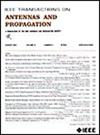磁共振应用中体表面积分方程矩阵的Tucker分解压缩
IF 4.6
1区 计算机科学
Q1 ENGINEERING, ELECTRICAL & ELECTRONIC
引用次数: 9
摘要
在这项工作中,我们提出了一种压缩体积表面积分方程(VSIE)公式中耦合矩阵的方法。VSIE方法用于磁共振成像(MRI)应用中的电磁(EM)分析,其中耦合矩阵对线圈和身体之间的相互作用进行建模。我们表明,这些效应可以用三维张量格式表示为远程元素之间的独立相互作用,然后用塔克模型进行分解。我们的方法可以与自适应交叉逼近(ACA)技术协同工作,以提供VSIE问题的快速解决方案。我们证明,我们的压缩方法可以通过有效使用现代图形处理单元(GPU)来加速产生的矩阵向量积,从而实现对内存要求过高的VSIE矩阵的使用。这对于在可行的计算时间内实现临床体素分辨率的数值MRI模拟至关重要。在本文中,我们证明了在将相关耦合矩阵从~80 TB压缩到~43 MB后,计算MRI线圈在具有1 mm3体素分辨率的数值身体模型内产生的EM场所需的VSIE矩阵矢量乘积可以在GPU中在~33 s内执行。本文章由计算机程序翻译,如有差异,请以英文原文为准。


Compression of Volume-Surface Integral Equation Matrices via Tucker Decomposition for Magnetic Resonance Applications
In this work, we propose a method for the compression of the coupling matrix in volume-surface integral equation (VSIE) formulations. VSIE methods are used for electromagnetic (EM) analysis in magnetic resonance imaging (MRI) applications, for which the coupling matrix models the interactions between the coil and the body. We showed that these effects can be represented as independent interactions between remote elements in 3-D tensor formats, and subsequently decomposed with the Tucker model. Our method can work in tandem with the adaptive cross approximation (ACA) technique to provide fast solutions of VSIE problems. We demonstrated that our compression approaches can enable the use of VSIE matrices of prohibitive memory requirements, by allowing the effective use of modern graphical processing units (GPUs) to accelerate the arising matrix-vector products. This is critical to enable numerical MRI simulations at clinical voxel resolutions in a feasible computation time. In this article, we demonstrate that the VSIE matrix-vector products needed to calculate the EM field produced by an MRI coil inside a numerical body model with 1 mm
3
voxel resolution, could be performed in ~33 s in a GPU, after compressing the associated coupling matrix from ~80 TB to ~43 MB.
求助全文
通过发布文献求助,成功后即可免费获取论文全文。
去求助
来源期刊
CiteScore
10.40
自引率
28.10%
发文量
968
审稿时长
4.7 months
期刊介绍:
IEEE Transactions on Antennas and Propagation includes theoretical and experimental advances in antennas, including design and development, and in the propagation of electromagnetic waves, including scattering, diffraction, and interaction with continuous media; and applications pertaining to antennas and propagation, such as remote sensing, applied optics, and millimeter and submillimeter wave techniques

 求助内容:
求助内容: 应助结果提醒方式:
应助结果提醒方式:


